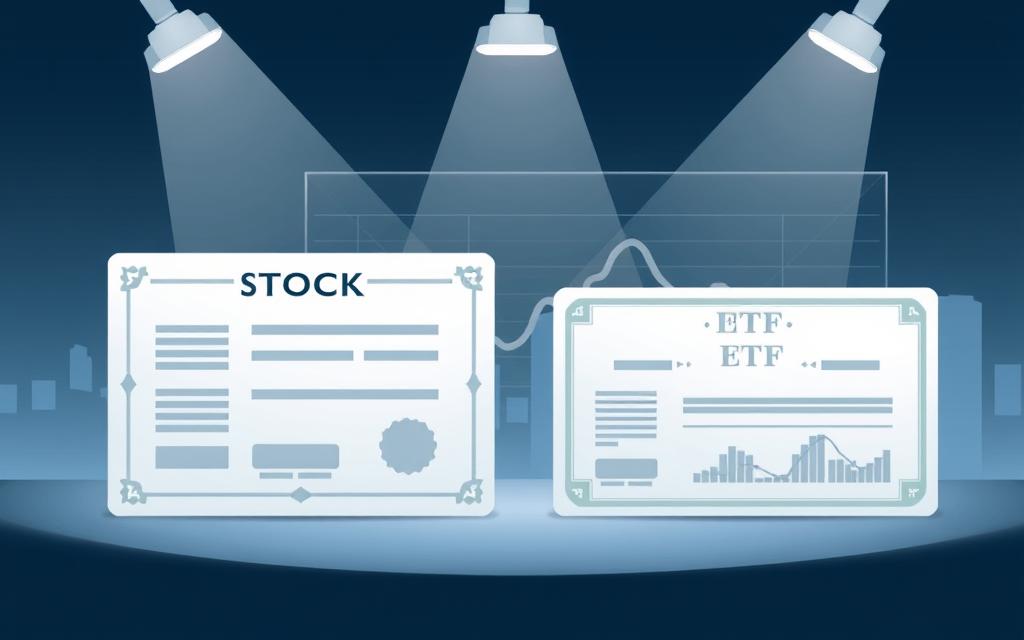Advertisement
Did you know nearly 55% of American households are in the stock market? With so many choices, it’s hard for beginners to know where to start.
As a new investor, choosing between individual stocks and ETFs is key. A beginner’s guide to stocks can help you grasp the basics. But knowing how they compare to ETFs is crucial.
This article will cover the stock market basics. It will help you decide which investment fits your financial goals. By the end, you’ll be ready to choose the right investment strategy for you.
Understanding Stocks and ETFs
The stock market offers many investment options. Stocks and ETFs are popular for beginners. It’s key to know what they are, how they work, and their differences.
What Are Stocks?
Stocks, or equities, mean owning a piece of a company. Buying stocks means you own a small part of the company’s assets and profits. They trade on stock exchanges like the New York Stock Exchange (NYSE) or NASDAQ. The stock’s value can change based on the company’s success and market trends.
Key characteristics of stocks include:
- Ownership in a company
- Potential for dividend payments
- Capital appreciation
- Voting rights in company decisions

What Are ETFs?
ETFs, or Exchange-Traded Funds, trade like stocks on stock exchanges. They hold a mix of securities, like stocks, bonds, or commodities. This lets investors diversify with one investment. ETFs aim to mirror the performance of a specific index, sector, or asset class.
Key benefits of ETFs include:
- Diversification
- Flexibility in trading
- Transparency in holdings
- Generally lower fees compared to actively managed mutual funds
Key Differences Between Stocks and ETFs
Knowing the differences between stocks and ETFs is vital for smart investing. Here are some main differences:
- Investment Type: Stocks are shares in one company, while ETFs are a mix of securities.
- Trading Flexibility: Both can be traded all day. But ETFs offer diversification with one trade.
- Risk: Stocks are riskier because they rely on one company’s success. ETFs spread risk across many securities.
- Management: Stocks don’t have management fees. But ETFs have expense ratios for management and operational costs.
By grasping these basics, beginner investors can better understand the stock market. They can make smarter choices for their investment portfolios.
Benefits of Investing in Stocks
For new investors, knowing the good things about stock investing is key. Stocks can grow your money and help reach your financial dreams.
Potential for High Returns
Stocks can lead to big gains over time. They often beat out bonds or savings, even with more risk. By picking strong companies, you can see your money grow and get dividends.
Ownership and Voting Rights
Investing in stocks makes you a shareholder of a company. You get to own a piece of it and vote on big decisions. It’s a way to feel like you own a part of something and help shape its future.
Flexibility in Choosing Individual Companies
Stocks let you pick the companies you want to invest in. You can choose based on what you care about, like tech or health. This way, you can make your investment plan fit your own goals and values.
Knowing these benefits helps new investors make smart choices about stocks. It’s important to think about the good and bad and how stocks fit into your big financial picture.
Benefits of Investing in ETFs
Investing in ETFs is a smart choice for beginners. ETFs, or Exchange-Traded Funds, offer many benefits. They are great for those new to investing.
Diversification Made Easy
ETFs provide instant diversification. By investing in an ETF, you get a piece of a large portfolio. This portfolio tracks a specific index, sector, or asset class. This diversification can reduce risk and increase potential returns over time.
For example, an ETF that tracks the S&P 500 index gives you exposure to 500 of the largest and most stable companies in the US. This spreads your risk and can smooth out market fluctuations.
Lower Expense Ratios
ETFs are known for being cost-effective. They have lower expense ratios compared to actively managed mutual funds. This means more of your money goes into the market, not into management fees.
Lower expense ratios can greatly impact your returns over time. For instance, an ETF with an expense ratio of 0.10% costs $1 per year for every $1,000 invested. This is much less than a mutual fund with an expense ratio of 1.00%, which costs $10 per year for the same investment.
Passive Management Options
Many ETFs are passively managed. They track a specific index rather than trying to beat it. This passive approach is good for investors who prefer a hands-off strategy.
- Passive management often results in lower fees.
- It can provide consistent returns that mirror the underlying index.
- It reduces the risk associated with individual stock picking or sector-specific investments.
By choosing passively managed ETFs, investors can enjoy diversification and cost-effectiveness. They don’t need to constantly rebalance their portfolios.
Risks Associated with Investing in Stocks
The stock market can lead to big gains, but it also comes with risks. Investing in stocks can be both rewarding and risky. There’s a chance for big returns, but there’s also a risk of losing a lot.
Market Volatility
Market volatility is a big risk in stock investing. Stock prices can change quickly because of many things. This includes economic news, world events, and how people feel about the market. If not handled well, this can lead to big losses.
- Economic downturns can lead to a decline in stock prices.
- Geopolitical tensions can cause market instability.
- Market sentiment can shift rapidly, affecting stock prices.
Company-Specific Risks
Investing in specific companies also comes with risks. Poor management, financial troubles, or industry changes can hurt a company’s stock. It’s key to do deep research on the companies you’re thinking of investing in.
- Review the company’s financial health and management team.
- Understand the industry trends and potential disruptions.
- Monitor news and updates about the company.
Emotional Decision-Making
Investors also face the risk of emotional decision-making. The stock market can be hard to predict, leading to quick decisions based on short-term changes. Having a solid investment plan and sticking to it can help avoid this risk.
For beginners, knowing the stock market and its risks is key. Guides like “stock market101” can offer helpful tips. By understanding the risks and following a disciplined approach, investors can manage the risks of stock investing better.
Risks of Investing in ETFs
For those new to investing, it’s key to understand the risks of ETFs. ETFs offer a diversified portfolio and flexibility. But, there are risks to be aware of.
Tracking Error
Tracking error is a major risk with ETFs. It happens when the ETF’s performance doesn’t match its underlying index. Several factors can cause this, like fees, trading costs, and the timing of trades.
- Fees and expenses can reduce returns, making the ETF underperform its benchmark.
- The way the ETF tracks the index also affects its performance.
- Trading costs, though low, can still impact the ETF’s return.
Industry Exposure
ETFs can have a lot of exposure to specific industries or sectors. This is called concentration risk. If the ETF focuses too much on one industry, a downturn in that sector can hurt the ETF’s performance.
For example, an ETF focused on tech stocks might do poorly during a tech downturn. It’s crucial for investors to check the ETF’s holdings. They should make sure they fit their risk tolerance and investment goals.
Liquidity Concerns
Liquidity is another important factor when investing in ETFs. Many ETFs are liquid, but some may have lower trading volumes. This can make it hard to buy or sell shares quickly or at a fair price.
Investors should watch out for ETFs with low average trading volumes. They might find it tough to exit their position.
How to Choose Between Stocks and ETFs
Choosing between stocks and ETFs depends on your goals, how much risk you can take, and how much time you have for research. As a beginner, knowing these factors is key to making a smart choice.
Assessing Your Investment Goals
First, you need to know what you want from your investment. Do you want it to grow over time, or do you need money regularly? Your goals will help decide which one is best for you.
- Long-term Growth: For growth, think about stocks in companies that are growing fast.
- Regular Income: For income, look at dividend stocks or ETFs that focus on income.
Understanding Your Risk Tolerance
Your comfort with risk is also important. Stocks can change a lot in value. ETFs, with their mix of investments, can be less risky.
Think about how you feel about market ups and downs when picking between stocks and ETFs.
Time Commitment for Research
Stocks need a lot of time to research, as you must keep up with company news and trends. ETFs, being a mix of many investments, need less time and effort.
- Think about how much time you can spend on your investments.
- Consider if you can make good choices based on market analysis.
By looking at your goals, understanding risk, and thinking about research time, you can pick stocks or ETFs that fit your financial plans.
The Importance of Diversification
Diversification is key in investing. It helps manage risk and can boost returns. By spreading investments, you protect your portfolio from big losses due to market ups and downs or company problems.
Why Diversification Matters
Diversification is important because it reduces risk. Investing in just one stock or a few can be risky. If one stock does poorly, it can hurt your whole portfolio. Diversification spreads this risk, so a loss in one investment can be balanced by gains in another.
Key benefits of diversification include:
- Reduced risk through varied investments
- Potential for more consistent returns over time
- Protection against market volatility
How ETFs Facilitate Diversification
ETFs (Exchange-Traded Funds) help diversify by pooling money from many investors. They invest in a variety of assets like stocks, bonds, or commodities. This makes it easier for individual investors to diversify with just one investment.
For example, an ETF that tracks the S&P 500 index gives you exposure to 500 big U.S. companies. This spreads your risk across different industries and sectors.
Stock Diversification Strategies
There are several ways to diversify a stock portfolio. One way is to invest in different sectors and industries. For example, you could invest in tech, healthcare, and consumer goods to spread your risk.
Another strategy is to diversify geographically. Investing in both domestic and international stocks can protect your portfolio from regional economic downturns.
| Diversification Strategy | Description | Benefits |
|---|---|---|
| Sector Diversification | Investing across different sectors like technology, healthcare, etc. | Reduces exposure to sector-specific risks |
| Geographical Diversification | Investing in both domestic and international stocks | Protects against regional economic downturns |
| Asset Class Diversification | Investing in different asset classes like stocks, bonds, commodities | Spreads risk across different asset classes |
Cost Considerations for Both Options
To make smart investment choices, knowing the costs of trading stocks and ETFs is key. Understanding these costs helps you get the most from your investments and avoid extra expenses.
Commissions and Fees in Stock Trading
Stock trading comes with a cost: the commission your brokerage firm charges for trades. These fees can differ a lot, with some brokers offering free trades.
Typical commission structures include:
- Flat fees per trade
- Percentage-based fees on the trade amount
- Account maintenance fees
For instance, one brokerage might charge $5 per trade, while another might take 0.5% of the trade amount. Knowing these fees helps you avoid surprise costs.
Expense Ratios in ETFs
ETFs usually cost less than mutual funds. The expense ratio is a percentage of the fund’s assets. It covers the ETF’s operational costs.
Key points to consider about ETF expense ratios:
- They are typically expressed as a percentage of the fund’s assets
- Lower expense ratios can lead to higher net returns over time
- Some ETFs offer very low expense ratios, specially those tracking broad market indices
| ETF Type | Typical Expense Ratio | Example |
|---|---|---|
| Index ETFs | 0.03% – 0.20% | Vanguard Total Stock Market ETF |
| Sector ETFs | 0.30% – 0.60% | Technology Sector ETF |
| Actively Managed ETFs | 0.50% – 1.00% | ARK Innovation ETF |
Hidden Costs to Watch For
Both stock and ETF investments have hidden costs. These include:
- Bid-ask spreads
- Market impact costs
- Tax implications
Knowing about these costs helps you make better choices. It can also help you save money on your investments.
Tips for Beginner Investors
Investing in stocks and ETFs can seem daunting at first. But with some guidance, you can start your investment journey with confidence. It’s key for beginners to build a strong foundation. This helps you make smart choices and move through the markets smoothly.
Start with a Budget
Before you jump into the stock market, figure out how much you can invest. Having a budget prevents financial stress and makes investing easier. Think about your income, expenses, and goals when setting your investment amount.
Starting small is a good approach. It lets you grow your investment as you get more familiar with the market.
Educate Yourself Continuously
The investing world is always changing. So, it’s important to keep learning. Use online courses, financial news websites, and investing books to stay up-to-date.
Knowing about market trends, economic signs, and company health is crucial. It helps you make better investment choices.
Consider a Financial Advisor
If you’re not sure where to start or how to manage your investments, think about getting advice from a financial advisor. They can tailor advice to fit your financial situation and goals.
A financial advisor can help you build a diverse portfolio. They can also share insights on market trends and help with any needed adjustments.
Resources for Learning More
As you explore the world of investing, having good resources is key. The investing world changes fast. It’s important to stay updated to make smart choices.
Online Courses and Webinars
Online courses and webinars are great for learning about stocks and ETFs. Sites like Udemy, Coursera, and edX have many courses. They cover everything from basics to advanced topics. These courses are taught by experts and include interactive parts to help you learn better.
Webinars offer live insights into market trends and investment strategies. They feature experienced investors and analysts. They share their knowledge and answer questions from the audience.
Books on Investing
If you like reading, there are many great books on investing. Classics like “A Random Walk Down Wall Street” by Burton G. Malkiel and “The Intelligent Investor” by Benjamin Graham are great for beginners. For more advanced investors, “The Big Short” by Michael Lewis is a good choice. It gives a detailed look at the financial crisis and the importance of understanding market dynamics.
Financial News Websites and Blogs
Keeping up with financial news is crucial for investors. Sites like The Motley Fool, Yahoo Finance, and CNBC have lots of information. They offer news, analysis, and insights to help you make informed decisions.
Also, many financial blogs provide deep analysis and commentary on the stock market. Following reputable bloggers and experts can give you different views. It helps you stay informed about the latest in the investment world.
Conclusion: Making the Right Choice
Choosing between stocks and ETFs as a beginner investor can be tough. But knowing the main differences helps you make a smart choice.
Key Takeaways
Stocks might offer big returns and let you own part of a company. But they also come with big risks. ETFs, on the other hand, spread out your risk, cost less, and are flexible. Think about your goals, how much risk you can take, and how much time you have for research when picking between stocks and ETFs.
Investing with Confidence
Beginner investors can learn from strategies for stocks and ETFs. Knowing your financial goals and how much risk you can handle helps you choose. You might also want to talk to financial experts or advisors for advice.
Your Next Steps
Now you know the pros and cons of stocks and ETFs. It’s time to start your investment journey. First, set a budget, keep learning, and look into different investment options. Whether you pick stocks or ETFs, the important thing is to invest wisely and stay up to date.



